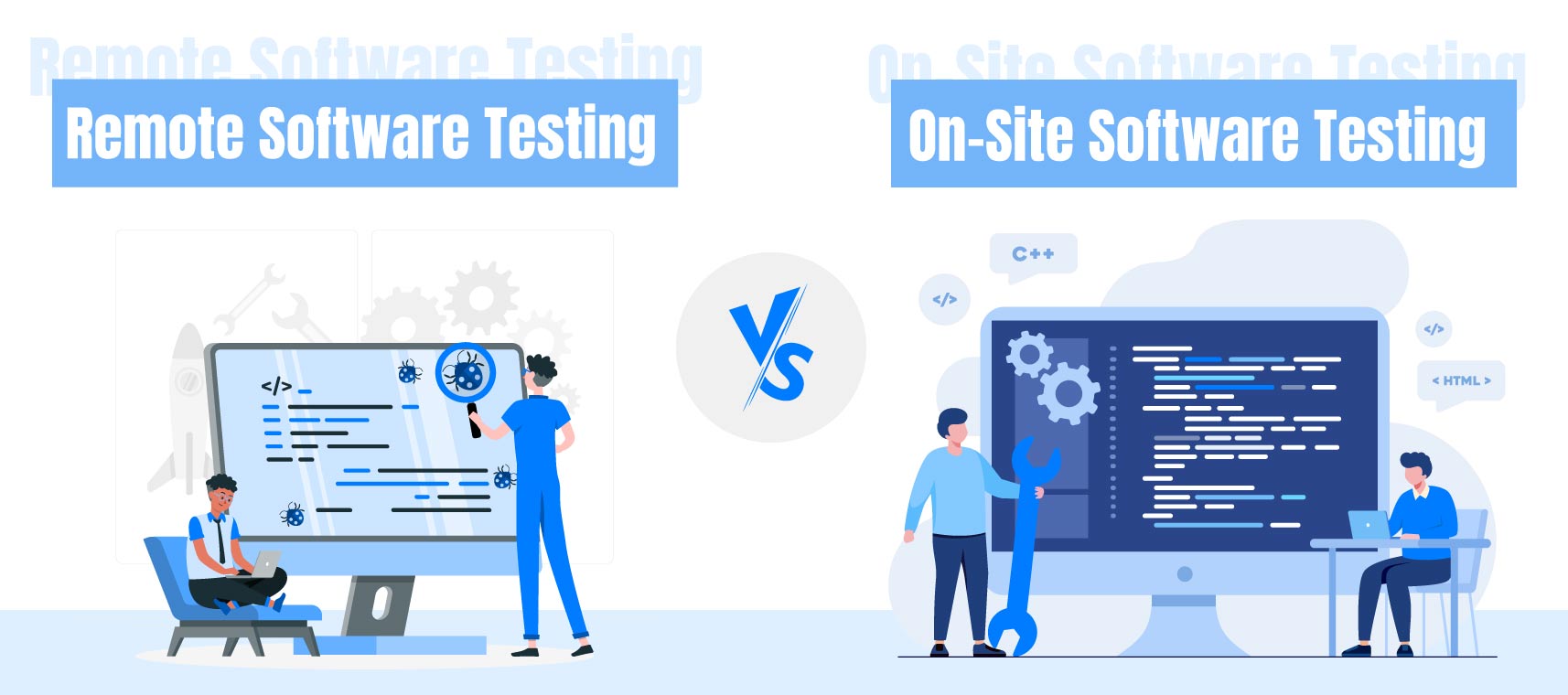
Remote Software Testing Vs. On-Site Testing: Choosing the Right Approach for Your Project
Have you ever found selecting the best testing strategy for your project difficult? Have you ever considered doing remote or on-site testing for your project? If the answers to the above questions are affirmative, this blog will play an essential part in this decision-making. Software testing services aim to create a friendly and safe testing environment. When deciding between the two, several criteria must be considered. We will explain them one by one for a better understanding.
Testing is essential for ensuring that your project’s end products are delivered effectively. Business testing (also known as User Acceptance Testing, or UAT) is typically performed by those who will use the product in practice. The goal of testing is to guarantee that the software is dependable, efficient and satisfies the user’s needs. Preventing faults is an essential aspect of the testing process. If faults are not addressed, they might develop into mistakes or bugs in the final product, causing severe issues.
Importance of choosing the appropriate software testing approach for your project
Choosing the correct software testing approach is essential to ensuring that the finished product satisfies the quality, performance, and functionality criteria specified by the consumers. A defined testing strategy allows for a greater focus on specific performance and functionality features of the product. It reduces or eliminates the possibility of lethal flaws while also improving overall program quality. One of the most challenging issues is determining the appropriate testing procedure at each stage.
For the efficient selection of testing techniques based on the requirements, the selection procedure should take into account both subjective and objective knowledge.
Remote software testing embraces flexibility and collaboration
Remote software testing is the process of testing software at a place other than where it was initially produced. One advantage of this testing is flexibility, which necessitates adaptability. Prepare to alter your testing plan to accommodate team meetings in different time zones or to meet deadlines. Flexibility also entails being open to new approaches and tools that enhance the remote software testing procedure. Flexibility is essential for firms with remote employees or teams who must interact and work on projects from many places.
Employees may use remote software to access the tools and resources they need to be productive, no matter where they are. This access can promote collaboration and communication, making it easier for teams to work together to achieve their objectives.
On-site testing for software provides direct interaction and immediate feedback
On-site software testing services enable consumers to offer direct input on the product. At the same time, it is being created, which may be extremely useful in discovering and fixing possible faults before it is published. Obtaining user feedback is a constant activity. Gathering and reviewing feedback is significant for identifying areas for improvement and keeping the product current with customer requirements and expectations. This can be performed through frequent polls, monitoring internet reviews, or holding focus groups.
By obtaining and assessing user input frequently, you can remain aware of your users’ changing wants and preferences, allowing you to make timely updates and product enhancements.
Key considerations in choosing the right approach
The following are a few pointers that one must consider when choosing the right software testing approach for their project.
- Evaluate Your Company’s Culture
Consider whether your company’s culture promotes cooperation, creativity, and teamwork. If so, remote or on-site testing may be a preferable option.
- Consider the nature of your work
If your job demands a lot of in-person cooperation, on-site employment can be the ideal alternative. If your job is more personal and can be completed remotely, remote or hybrid work may be a better match.
- Survey your workforce
Consider polling your staff to understand their preferences and requirements better. Inquire about their productivity levels while working remotely, comfort levels when returning to the office, and preferred work paradigms.
- Determine the logistics
Consider the logistics of implementing multiple work patterns, including real estate and collaboration tool costs, hybrid team scheduling and coordination, and employee productivity and engagement.
Conclusion
The COVID-19 epidemic has exacerbated the trend toward remote and hybrid employment, and many businesses are reconsidering their approach to work. While each work style has advantages and disadvantages, there is no universally applicable answer. Choosing the best work model for your project necessitates a careful examination of your company culture, the nature of your job, and the preferences of your employees.
By considering all aspects and evaluating various work models, you can design a work environment that maximizes productivity, engagement, and employee happiness.
Useful Resources:
Recent Blogs
- The Gig Renaissance: Why Smart Businesses Hire Remote React Native Developers on Contract
- Hire Remote Golang Developers: Powering Cloud-Native and Microservices Growth
- Hire Best Remote Software Developers: Why AI Can’t Replace Human Expertise
- Low-Code RPA: Empowering Citizen Developers Through Automation
- RPA Software Solution: Intelligent Document Processing with RPA
Categories
- Agritech (1)
- AR/VR (5)
- Artificial Intelligence (55)
- Machine Learning (1)
- Blockchain (4)
- Business Intelligence (3)
- CRM (5)
- SalesForce (4)
- Data Engineering (8)
- Data protection (2)
- Development (103)
- Golang Development (16)
- Python Web Development (9)
- React JS (5)
- React native (10)
- Devops (3)
- Hire Developers (4)
- Internet of Things (IoT) (5)
- Kubernetes (2)
- Machine Learning (2)
- Mobile App Development (44)
- Node.js (7)
- outsourcing (7)
- Partnership (4)
- Performance Testing (3)
- RPA (24)
- Security (24)
- Strategy (1)
- Testing (110)
- Accessibility Testing (2)
- Automation Testing (22)
- Dynamic Testing (1)
- Manual Testing (3)
- Mobile App Testing (13)
- Offshore Software Testing (6)
- Penetration Testing Services (13)
- QA testing (16)
- Remote Software Testing (7)
- Software Testing (19)
- Website Design (22)